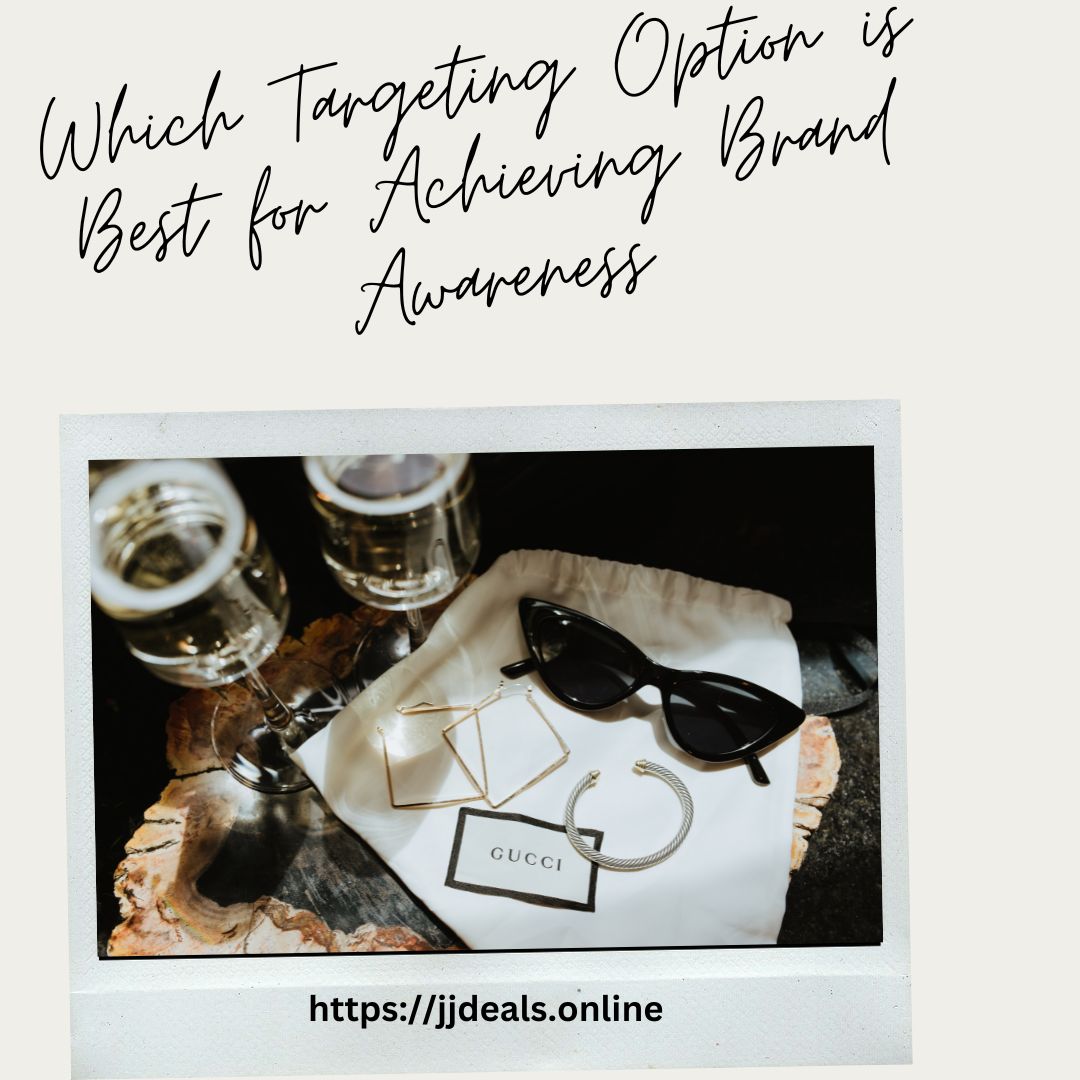
Which Targeting Option is Best for Achieving Brand Awareness
Which targeting option is best for achieving brand awareness.
Exploring Targeting Options for Achieving Brand Awareness
Introduction: Which Targeting Option is Best for Achieving Brand Awareness
Brand awareness plays a pivotal role in the success of any business. It helps consumers recognize, recall, and form associations with a brand, influencing their purchasing decisions. In the digital age, brands have access to various targeting options to reach their desired audience effectively. In this blog post, we will delve into different targeting options and evaluate their effectiveness in achieving brand awareness.

Which Targeting Option is Best for Achieving Brand Awareness – Demographic targeting
Demographic targeting is a marketing strategy that focuses on segmenting the target audience based on specific demographic characteristics. These characteristics commonly include age, gender, income, education, and location. By understanding these demographics, brands can create more targeted and personalized marketing campaigns, ensuring that their messaging and creative assets resonate with specific groups of individuals who are more likely to engage with their brand.
- Age: Segmenting the audience by age allows brands to cater their messaging to different generational cohorts. For example, a brand targeting younger audiences may employ more youthful and trendy language and visuals, while a brand targeting older demographics may adopt a more mature and sophisticated tone. Understanding the age range of the target audience enables brands to align their campaigns with the preferences and values associated with each age group.
- Gender: Gender-based targeting involves tailoring marketing efforts to appeal to either males or females, or sometimes to specific gender identities. By recognizing the different interests, needs, and preferences between genders, brands can create content that speaks directly to the intended audience. This approach allows for more effective communication and resonates with consumers on a more personal level.
- Income: Income-based targeting focuses on segmenting the audience based on their income levels. Brands can tailor their messaging and pricing strategies to align with the purchasing power of different income brackets. For example, luxury brands may target higher-income individuals by emphasizing exclusivity and premium quality, while budget-friendly brands may appeal to price-conscious consumers by highlighting affordability and value.
- Education: Education-based targeting considers the level of education attained by the target audience. This demographic factor can influence the complexity of the messaging and the tone used in marketing campaigns. Brands targeting highly educated individuals may emphasize technical details and in-depth information, while brands targeting less educated individuals may adopt a simpler and more accessible approach.
- Location: Geographic location is a crucial demographic factor that allows brands to target consumers based on their specific geographic regions. Local businesses can focus their efforts on reaching consumers within a specific radius, while global brands may customize their messaging to resonate with different cultural and regional preferences. Location-based targeting also enables brands to incorporate relevant regional references and adapt their campaigns to local customs and traditions.
By understanding the demographics of their target audience, brands can craft campaigns that speak directly to the interests and preferences of specific groups. This approach enhances the likelihood of capturing the attention and resonating with consumers, ultimately increasing brand awareness and driving engagement. However, it is important to note that demographic targeting should be complemented with other targeting strategies to create a comprehensive and effective marketing approach.
Which Targeting Option is Best for Achieving Brand Awareness – Psychographic targeting
Psychographic targeting is a marketing approach that goes beyond demographic factors and delves into the psychological and behavioral characteristics of consumers. It involves analyzing aspects such as lifestyle, values, interests, attitudes, and opinions to gain a deeper understanding of the target audience. By tapping into these psychographic elements, brands can create compelling brand stories and messaging that resonates on a more emotional and personal level, leading to enhanced brand recall and awareness.
- Lifestyle: Understanding the lifestyle of the target audience involves examining their daily routines, activities, hobbies, and social behaviors. By identifying the interests and preferences that align with the brand’s offerings, marketers can develop campaigns that showcase how their products or services fit seamlessly into the target audience’s lifestyle. For example, a fitness brand may focus on individuals who lead an active and health-conscious lifestyle, highlighting how their products can enhance their exercise routines and well-being.
- Values: Values reflect the fundamental beliefs and principles that individuals hold dear. Psychographic targeting allows brands to identify the values that resonate with their target audience and align with their brand identity. By appealing to shared values, brands can connect with consumers on a deeper level and build trust and loyalty. For instance, a sustainable fashion brand may target environmentally conscious consumers by emphasizing their commitment to ethical sourcing and production practices.
- Interests: Interests refer to the specific topics, hobbies, or activities that captivate individuals. By understanding the interests of the target audience, brands can create content and campaigns that cater to those specific areas of fascination. This approach enables brands to engage consumers by providing relevant and engaging information or experiences related to their interests. For example, a travel brand targeting adventure enthusiasts may focus on showcasing thrilling and off-the-beaten-path destinations and activities.
- Attitudes and Opinions: Psychographic targeting involves analyzing the attitudes and opinions of the target audience towards various subjects. This includes their perceptions, beliefs, and opinions about products, brands, and societal issues. By aligning with the attitudes and opinions that resonate with the target audience, brands can position themselves as a reflection of their consumers’ values and perspectives. This alignment creates a sense of belonging and strengthens the emotional connection between the brand and the consumer.
Psychographic targeting allows brands to move beyond superficial demographic characteristics and tap into the deeper motivations and aspirations of their target audience. By tailoring their messaging, brand stories, and creative assets to align with the psychological and behavioral characteristics of consumers, brands can forge a strong emotional connection. This connection enhances brand recall, fosters positive brand associations, and ultimately leads to increased brand awareness and loyalty. Psychographic targeting helps brands position themselves as more than just a product or service but as a lifestyle choice that resonates with their consumers’ identities and aspirations.
Which Targeting Option is Best for Achieving Brand Awareness – Interest-based targeting
Interest-based targeting is a marketing strategy that focuses on identifying and targeting individuals based on their demonstrated interests and online behaviors. This approach leverages data from various sources, including browsing history, search queries, social media interactions, and other online activities, to gain insights into the topics and subjects that individuals have shown interest in. By understanding these interests, brands can deliver relevant content and advertisements to a receptive audience, thereby raising brand awareness effectively.
- Browsing History: By analyzing an individual’s browsing history, brands can gain insights into the websites they visit, the pages they view, and the products or services they research. This information helps identify their specific areas of interest and allows brands to target them with relevant content or ads. For example, an individual who frequently visits fashion blogs and online clothing stores may be targeted with ads showcasing the latest fashion trends or discounts on clothing items.
- Search Queries: Search queries provide valuable information about what individuals are actively seeking information about or looking to purchase. Brands can target individuals based on specific keywords and phrases they search for, ensuring that their content or advertisements are relevant to their search intent. For instance, a travel agency may target individuals who search for “best vacation destinations” with ads promoting their travel packages and itineraries.
- Social Media Interactions: Social media platforms collect vast amounts of data on users’ interactions, including likes, comments, shares, and follows. By analyzing these interactions, brands can gain insights into individuals’ interests, preferences, and behaviors. This information helps identify individuals who have shown interest in topics related to the brand’s offerings. For example, a fitness brand may target individuals who follow fitness influencers or engage with fitness-related content on social media platforms.
- Online Activities: Beyond browsing history, search queries, and social media interactions, brands can also gather data from various online activities such as content consumption, email subscriptions, and participation in online communities. By monitoring these activities, brands can identify individuals who actively engage with content or communities related to their brand or industry. Targeting these individuals with relevant content or advertisements can raise brand awareness and capture their attention effectively.
Interest-based targeting allows brands to reach individuals who have already demonstrated an interest in specific topics or subjects related to their brand. By delivering content or ads that align with these interests, brands can capture the attention of a receptive audience and increase brand awareness. This approach ensures that marketing efforts are focused on individuals who are more likely to engage and convert, resulting in a higher return on investment for brand awareness campaigns.
Which Targeting Option is Best for Achieving Brand Awareness – Contextual targeting
Contextual targeting is a marketing strategy that involves placing advertisements in environments that are relevant to a brand’s values and offerings. This approach focuses on selecting websites, blogs, or platforms that cover topics or have content related to the brand’s industry. By ensuring that ads are displayed to individuals who are actively engaged in relevant content, brands can increase the chances of capturing their attention, raising brand awareness, and fostering a connection within the appropriate context.
- Relevance to Brand Values: Contextual targeting ensures that ads are displayed in environments that align with a brand’s values. For example, a sustainable fashion brand may choose to place ads on websites or blogs that promote eco-friendly lifestyles or discuss sustainable fashion practices. By associating the brand’s ads with content that reflects its values, brands can enhance brand perception and create a positive brand image among the target audience.
- Alignment with Industry: Contextual targeting focuses on selecting platforms that cover topics or have content related to the brand’s industry. This ensures that ads are placed in environments where individuals are already seeking information or engaging with content that is directly relevant to the brand’s offerings. For instance, a sports equipment brand may choose to display ads on sports-related websites or blogs. By doing so, the brand can target individuals who have a specific interest in sports, increasing the likelihood of capturing their attention and raising brand awareness within a relevant context.
- Engaged Audience: Contextual targeting allows brands to reach individuals who are actively engaged with relevant content. When ads are displayed alongside content that individuals are actively consuming or seeking, it increases the likelihood of their attention being captured. By targeting individuals who have already shown an interest in the topic or industry related to the brand, contextual targeting enables brands to connect with an audience that is more likely to engage with the ad and be receptive to the brand’s message.
- Enhanced Brand Perception: By placing ads in the right context, brands can enhance their brand perception and association with specific topics or industries. When individuals see ads in an environment that aligns with their interests or needs, it creates a subconscious connection between the brand and the content they value. This association helps to reinforce the brand’s authority, credibility, and relevance within the industry, contributing to increased brand awareness and recognition.
Contextual targeting allows brands to strategically position their ads in environments that resonate with their values, industry, and target audience’s interests. By ensuring that ads are displayed within relevant content, brands can increase the likelihood of capturing the attention of individuals who are actively engaged in topics related to the brand’s offerings. This approach not only raises brand awareness but also helps to foster a positive brand perception and association within the appropriate context.
Influencer Targeting
Influencer targeting is a marketing strategy that involves partnering with individuals who have established a significant following and influence within specific niches or industries. These individuals, known as influencers, have a dedicated community of followers who trust their recommendations and engage with their content. By collaborating with influencers whose audience aligns with their target market, brands can leverage their reach and influence to amplify brand awareness and generate authentic engagement.
- Reach and Influence: Influencers have built a substantial following across various social media platforms, such as Instagram, YouTube, TikTok, or blogs. They have cultivated a community of engaged followers who actively consume their content and trust their recommendations. By partnering with influencers, brands gain access to their audience and can tap into their reach and influence to expand their brand’s visibility and reach a larger audience.
- Targeted Audience: Influencers typically have a specific niche or industry focus, and their followers are often interested in that particular niche. When brands collaborate with influencers whose audience aligns with their target market, they can ensure that their message reaches individuals who are more likely to be interested in their products or services. This targeted approach helps brands raise brand awareness among a relevant audience, increasing the chances of generating genuine interest and engagement.
- Authenticity and Trust: One of the key advantages of influencer targeting is the ability to generate authentic content and recommendations. Influencers have built a relationship of trust with their followers, who value their opinions and perceive them as authentic and relatable. When influencers endorse a brand’s products or services, their followers are more likely to trust and consider those recommendations. This authenticity helps brands establish credibility and build a positive association with their target audience, contributing to increased brand awareness and recognition.
- Content Creation and Engagement: Influencers are skilled content creators who understand their audience’s preferences and interests. When collaborating with influencers, brands can benefit from their creativity and expertise in developing engaging and relevant content. Influencers can create sponsored posts, videos, or other types of content that seamlessly integrate the brand’s message into their own authentic style. This type of content sparks interest and encourages engagement from their followers, generating buzz and raising brand awareness in a more organic and impactful way.
- Amplifying Brand Awareness: By partnering with influencers, brands can tap into the power of word-of-mouth marketing. Influencers’ recommendations and endorsements act as a form of social proof, which can significantly impact brand perception and awareness. When influencers promote a brand’s products or services, their followers are more likely to take notice, explore the brand further, and share their positive experiences with others. This amplifies brand awareness, as the brand’s message is disseminated through the influencer’s dedicated fan base.
Influencer targeting allows brands to leverage the reach, influence, and authenticity of individuals who have established a significant following in specific niches or industries. By collaborating with influencers whose audience aligns with their target market, brands can tap into an engaged community of followers and generate buzz around their brand. Through authentic recommendations and content creation, influencers help raise brand awareness, establish credibility, and foster genuine connections with the target audience.

Conclusion
Achieving brand awareness requires a strategic approach to targeting the right audience. By employing a combination of demographic, psychographic, interest-based, contextual, and influencer targeting, brands can maximize their chances of reaching and connecting with their desired audience. Each targeting option has its strengths and can be leveraged depending on the brand’s goals, industry, and available resources. Remember, effective targeting coupled with compelling messaging and consistent brand identity is key to building a strong brand presence and fostering lasting brand awareness.
7 Creative Ways to Improve Customer Loyalty and Retention
The Latest Branding Trends You Need To Know





